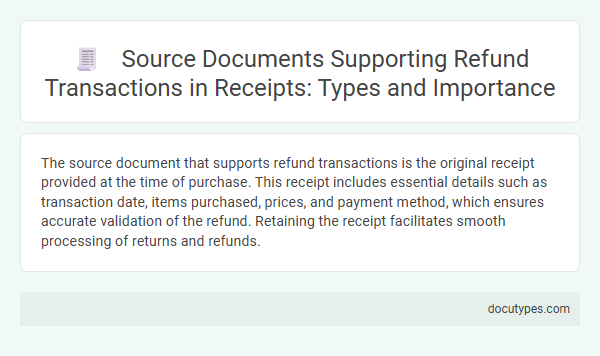The source document that supports refund transactions is the original receipt provided at the time of purchase. This receipt includes essential details such as transaction date, items purchased, prices, and payment method, which ensures accurate validation of the refund. Retaining the receipt facilitates smooth processing of returns and refunds.
Introduction to Source Documents in Refund Transactions
Source documents play a crucial role in verifying refund transactions by providing original evidence of the purchase. These documents ensure accuracy and accountability in the refund process.
Receipts are the primary source documents supporting refund transactions, detailing the item purchased, price, date, and vendor. They establish proof of the original sale, which is essential for processing refunds accurately. Without these documents, businesses risk errors and fraudulent claims during refund handling.
Defining Refund Transactions in Receipts
| Topic | Details |
|---|---|
| Source Document for Refund Transactions | A refund transaction in receipts is supported by the original sales receipt or proof of purchase. This document verifies the transaction and validates the refund process. |
| Definition of Refund Transactions | Refund transactions involve returning funds to a customer after a returned item or service cancellation. The receipt clearly records the refund amount, date, and authorization details. |
| Role of Receipts in Refunds | Receipts serve as a critical source document to trace the original purchase, ensuring accuracy and preventing fraud during refund handling. |
| Your Responsibilities | You should always keep your original receipt to facilitate smooth refund transactions and maintain accurate financial records. |
Importance of Source Documents in Refund Processes
Source documents such as refund receipts, original purchase invoices, and return authorization forms support refund transactions by providing proof of the original sale and customer eligibility. These documents ensure accuracy in processing refunds, prevent fraud, and maintain transparent financial records. Your refund process relies on these verifiable records to safeguard both the customer's rights and the business's accountability.
Common Types of Source Documents Supporting Refunds
Source documents are essential for verifying refund transactions, ensuring accuracy and accountability in financial records. Common types of source documents supporting refunds include credit memos, return authorizations, and original sales receipts. You should always retain these documents to facilitate smooth refund processing and audit compliance.
Role of Original Sales Receipts in Refund Verification
Original sales receipts serve as the primary source document supporting refund transactions by verifying the legitimacy of the purchase. These receipts provide critical transaction details needed to process accurate and authorized refunds.
- Proof of Purchase - Original sales receipts confirm the date, items, and price of the purchase necessary for validating refunds.
- Transaction Reference - Receipts include unique transaction numbers that help track and reconcile refund requests with sales records.
- Refund Authorization - Retailers use the details on the original receipt to approve or deny refund claims ensuring compliance with return policies.
Credit Note as Source Document for Refunds
Credit notes serve as the primary source document supporting refund transactions. They provide official acknowledgment of a refund issued to a customer.
- Credit Note Definition - A credit note is a document issued to correct or cancel a previous invoice, reflecting refunds or adjustments.
- Refund Authorization - It authorizes the refund by detailing the amount credited back to the customer's account or payment method.
- Accounting Records - Credit notes ensure accurate accounting by linking refund transactions to the original sales records.
Your refund process relies on credit notes as verifiable evidence for refund approval and record-keeping.
Debit Note Usage in Refund Transactions
What source document supports refund transactions in accounting? A debit note is commonly used as the source document to authorize and record refund transactions. This document details the amount to be refunded and serves as proof for both parties involved in the transaction.
Supporting Documents: Return Authorization Forms
Refund transactions require specific source documents to ensure accuracy and accountability. Return Authorization Forms serve as the essential supporting documents needed to process your refunds correctly.
- Return Authorization Form Validation - This document verifies that the return request has been approved by the seller or company prior to the refund.
- Customer and Transaction Details - It includes key information such as customer name, purchase date, and reason for return to support the refund claim.
- Authorization Tracking - Return Authorization Forms help businesses track and audit refund transactions for compliance and record-keeping purposes.
Audit Trail: Source Documents and Regulatory Compliance
Source documents such as receipts and credit memos support refund transactions by providing a clear audit trail. These documents are essential for verifying transaction accuracy and ensuring regulatory compliance.
Your refund process relies on maintaining detailed records to facilitate audits and prevent discrepancies. Proper documentation strengthens financial accountability and meets legal requirements for transaction validation.
What Source Document Supports Refund Transactions? Infographic

